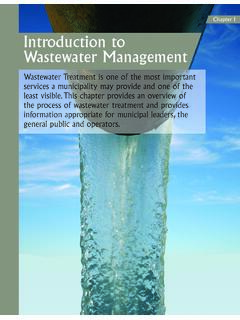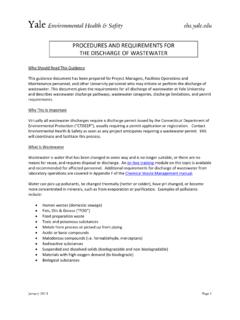Transcription of ADVANCED WASTEWATER TREATMENT TECHNOLOGIES
1 ADVANCED WASTEWATER TREATMENT . TECHNOLOGIES . With the Support of Prepared By: Gujarat Cleaner Production Centre- ENVIS Centre (Supported by Ministry of Environment Forest & Climate Change, Government of India). Forests & Environment Department Government of Gujarat Gujarat Cleaner Production Centre (GCPC), 2016. This publication may be produced in whole or in part and in any form for educational or non-profit purposes without special permission from the copyright holder, provided acknowledgement of the source is made. GCPC would appreciate receiving a copy of any publication that uses this publication as a source. No use of this publication may be made for resale or for any other commercial purpose whatsoever without prior permission in writing from the GCPC. This publication is not intended as a recommendation of any particular technology, process or method. It is offered for educational and informational purpose. To the extent permitted by law, the entire risk of loss, damage or unsatisfactory performance of the program rests with the user.
2 In no event will the Agencies be liable for damages, including any general, special, incidental or consequential damages, arising out of the use of the any material. The numerical data and formulas contained in the Program are provided solely for the purpose of illustrating the capabilities. The agencies give no warranty as to the accuracy, reliability, timeliness or other features of any data contained herein. The user should rely on the User's own inquiries to determine the current status. Users who re-disseminate the information should include the disclaimer and conditions of use in its current form and identify any modifications made by the users. The document is intended to provide guidance on ADVANCED WASTEWATER TREATMENT TECHNOLOGIES . measures at ETP, CETP as well as STP to improve treated water quality by ADVANCED TREATMENT . Title: ADVANCED WASTEWATER TREATMENT TECHNOLOGIES . Published in the year: 2016. Team for Compilation: Dr.
3 Bharat Jain, Member Secretary, GCPC & Coordinator, ENVIS. Mr. Rathod, Programme Officer, ENVIS. Mr. Sumit Patel, Assistant Project Engineer, GCPC. Ms. Disha Bhavsar, Assistant Project Engineer, GCPC. Ms. Priyanka Joshi, Information Officer, ENVIS. Mr. Heer Desai, Project Assistant, GCPC-ENVIS. Gujarat Cleaner Production Centre ENVIS Centre 3rd Floor, Block No. 11&12. Udhyog Bhavan, Sector-11. Gandhinagar, Gujarat-382017. (India). Tel: +91 79 23244147. Email: Website: , About us Gujarat Cleaner Production Centre (GCPC) has been established in the year 1998 by the Department of Industries and Mines, Government of Gujarat with technical support of United Nations Industrial Development Organization (UNIDO). GCPC acts an environmental advisor of Gujarat Industrial Development Corporation (GIDC), Government of Gujarat to solve environmental problems faced by SMEs at GIDC Industrial Estates. GCPC is actively engaged in promotion of Cleaner Production (CP) and Clean Technology (CT) through various activities such as organizing orientation and awareness programmes and conducting cleaner production assessment projects across the state.
4 GCPC is a regular member of RECPnet The Global Network on Resource Efficient and Cleaner Production of UNIDO and CTCN Climate Technology Centre and Network, a working arm of UNFCCC The United Nations Framework Convention on Climate Change. GCPC is acting as an Environmental Information System (ENVIS) Centre for Ministry of Environment, Forest and Climate Change, Government of India since 2005, with objective to disseminate and promote the theme of cleaner production and clean technology' and other environmental practices across industries, students, academicians, researchers to create sustainable development in the state of Gujarat. GCPC has played active role in framing Gujarat Industrial Policy, 2009 and 2015 and many financial assistance schemes, pertaining to Cleaner Production and Clean Technology in the state of Gujarat. GCPC has so far conducted more than 200 orientation programmes in various academic institution and industries associations.
5 The centre has successfully completed more than 100. Cleaner Production Demonstration Projects in various industrial sectors such as Textile, Dairy, Pulp and Paper, Chemical, Petrochemical, Pharmaceutical, Fish Processing, Ceramic and Glass etc. Foreword Gujarat is proactive towards WASTEWATER TREATMENT . Presently 37 CETPs are in the state, out of which 33 CETPs are operational and 4 are either proposed or at commissioning/construction stage. Out of 33 operating CETPs 9 Nos. are exclusively for treating effluent generated from textile sectors and 2 for electroplating sector while the rest are for chemical and other allied industries. Total TREATMENT Capacity of operational CETPs is proposed CETPs will be & MLD. In each industrial estate of Gujarat, estate wise or sector wise WASTEWATER TREATMENT facilities are designed. More than 20 WASTEWATER TREATMENT facilities are based on Traditional or Conventional WASTEWATER TREATMENT which includes Mechanical methods (Flotation, clarification (settlement/thickening) or filtration), Biological methods (Aerobic / anaerobic methods, (primary and secondary clarification)) and Chemical methods (Precipitation + (clarification or flotation).)
6 Most of CETPs receives mix effluent (cocktail).Therefore these TREATMENT facilities are not able to achieve the discharge norms. If treated effluent from these plants discharged into a stream with low flow can cause damage to aquatic life by reducing the dissolved oxygen content. In addition the secondary effluent contains significant amounts of plant nutrients, Suspended solids and dissolved solids. Due to stringent regulations for disposal of WASTEWATER coupled with water stress and scarcity in certain areas there is a great need of ADVANCED WASTEWATER TREATMENT with parameter wise WASTEWATER stream segregation as segregated WASTEWATER stream can be easily treated and it may have potential to achieve discharge norms to satisfy any of the several specific goals. Gujarat Cleaner Production Centre (GCPC) promotes the concept of CP (Cleaner Production) & CT. (Clean Technology). As a part of it this publication introduces the concept of ADVANCED WASTEWATER TREATMENT including its working principle, procedure, implementation, advantages, disadvantages, application, case study etc and removal of (1) suspended solids (2) BOD (3).
7 Plant nutrients (4) dissolved solids and (5) toxic substances. These TREATMENT TECHNOLOGIES may be introduced at any stage of the total TREATMENT process as in the case of industrial waterways or may be used for complete removal of pollutants after secondary TREATMENT . Hopefully this publication will be useful for all the stakeholders of WASTEWATER TREATMENT facility. Dr. Bharat Jain Member Secretary, GCPC & Coordinator, ENVIS. Gujarat Cleaner Production Centre INDEX. Sr. No TREATMENT TECHNOLOGIES Page No 1 Automated Chemostat TREATMENT (ACT) 08. 2 Soil Biotechnology (SBT) 14. 3 Reed Bed Technology (RBT) 27. 4 Hydrodynamic cavitation (HDC) 34. 5 Membrane Bio reactor (MBR) 41. 6 Moving Bed Biological Reactor (MBBR) 49. 7 Wet Air Oxidation (WAO) 56. 8 Ozonation 59. 9 Electrocoagulation (EC) 65. 10 Fenton 71. 11 Sequencing Batch Reactor (SBR) 79. Abbreviations ETP Effluent TREATMENT plant CETP Common effluent TREATMENT plant TDS Total dissolved solid TSS Total suspended solid VSS Volatile suspended solid BOD Biochemical oxygen demand COD Chemical oxygen demand ASP Activated sludge process SRT sludge retention time SOR sludge overflow rate WOR weir overflow rate MLD Million liter per day MLSS Mixed liquor suspended solid MLVSS Mixed liquor volatile suspended solid TS Total solids MoEFCC Ministry of Environment, Forest &.
8 Climate Change CAPEX Capital Expenditure OPEX Operational Expenditure SAD Specific Aeration Demand DAF Dissolved Air Floatation SMP Soluble Microbial Product IMBR Immersed Membrane Bioreactor SMBR Submerged Membrane Bioreactor TPH Total Petroleum Hydrocarbons GUJARAT CLEANER PRODUCTION CENTRE-ENVIS CENTRE ADVANCED WASTEWATER TREATMENT TECHNOLOGIES . INTRODUCTION. WASTEWATER . WASTEWATER , also written as waste water, is any water that has been adversely affected in quality by anthropogenic influence. WASTEWATER can originate from a combination of domestic, industrial, commercial or agricultural activities, surface runoff or storm water, and from sewer inflow or infiltration. Municipal WASTEWATER (also called sewage) is usually conveyed in a combined sewer or sanitary sewer, and treated at a WASTEWATER TREATMENT plant. Treated WASTEWATER is discharged into receiving water via an effluent pipe. Wastewaters generated in areas without access to centralized sewer systems rely on on-site WASTEWATER systems.
9 These typically comprise a septic tank, drain field, and optionally an on-site TREATMENT unit. The management of WASTEWATER belongs to the overarching term sanitation, just like the management of human excreta, solid waste and storm water (drainage).Industrial WASTEWATER is defined as any WASTEWATER generated from any manufacturing, processing, institutional, commercial, or agricultural operation, or any operation that discharges other than domestic or sanitary WASTEWATER . WASTEWATER GENERATION. Rapid industrialization has resulted in the generation of huge quantity of WASTEWATER from industrial sectors such as sugar, pulp and paper, fruit and food processing, sago / starch, distilleries, dairies, tanneries, slaughterhouses, poultries, etc. Despite requirements for pollution control measures, these WASTEWATER are generally dumped on land or discharged into water bodies, without adequate TREATMENT , and thus become a large source of environmental pollution and health hazard.
10 WASTEWATER management in India has become an extremely important area of focus due to increasing health awareness and population pressure. Despite the WASTEWATER sector witnessing major growth in the last decade due to increasing government support and private participation, the scale of the problem remains enormous. For instance, it is estimated that less than 20% of domestic and 60% of industrial WASTEWATER is treated. Metros and large cities (more than 100,000 inhabitants) are treating only about of their WASTEWATER ; smaller cities treat only of their WASTEWATER . Industrial WASTEWATER includes industrial effluents (with or without pre- TREATMENT ), but sometimes also cooling water from energy production and 1. GUJARAT CLEANER PRODUCTION CENTRE-ENVIS CENTRE ADVANCED WASTEWATER TREATMENT TECHNOLOGIES . mining water. The slight improvement in WASTEWATER quantity is mostly based on reduction in the production process, and not always because of improvements or constructions of effective TREATMENT INDUSTRIALIZATION IN GUJARAT.



